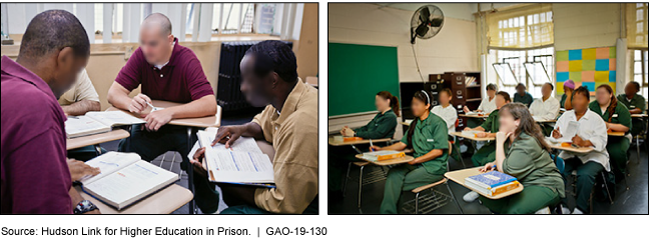Federal Student Aid: Actions Needed to Evaluate Pell Grant Pilot for Incarcerated Students
Fast Facts
Federal Pell grants help open the door to a college education for millions of low-income students every year. However, students in prison are generally ineligible for the grants.
The Department of Education is experimenting with changing that in its Second Chance Pell pilot. Since 2015, 59 schools participating in the pilot have awarded about $35 million in Pell grants to about 8,000 incarcerated students.
The department collects data from participating schools but hasn't determined how to evaluate the pilot—which could help decide the future of Pell grants for students in prison. We recommended evaluating and reporting on the pilot.
Incarcerated students in classrooms at correctional facilities

These are two photos of students in prison classrooms. The first is a class with men and the second is a class with women.
Highlights
What GAO Found
The Department of Education (Education) selected 64 schools across 26 states to participate in the Second Chance Pell pilot, and participating schools collaborated with prisons and other stakeholders to implement the pilot. Across the pilot's first 2 years, schools awarded approximately $35.6 million in Pell grants to about 8,800 incarcerated students.
Officials from the 12 schools GAO interviewed reported experiencing some challenges implementing the pilot. First, school officials said they experienced challenges establishing incarcerated applicants' eligibility for Pell grants, since some applicants had not registered for Selective Service and some had an existing federal student loan in default. However, many applicants were able to complete the necessary steps—such as making a set number of payments on their defaulted loans—to reestablish eligibility. Second, obtaining documents from incarcerated applicants to support verification—which helps the department's efforts to reduce improper payments of federal student aid—was another challenge officials reported. School officials also said that providing college classes in prisons required them to develop new processes and creative solutions to overcome technology limitations, space limitations, and the transfer of students to other prisons. Officials from 8 of 12 schools told GAO they hired additional staff or developed new approaches in response to their pilot efforts.
Incarcerated College Students inside New York's Sing Sing Correctional Facility

Education monitors the pilot by collecting data from participating schools, but had not established how it intended to evaluate Second Chance Pell or measure the pilot's performance against its objectives. Education is required to review and evaluate experiments under the Experimental Sites Initiative—of which Second Chance Pell is a part—and make recommendations, as appropriate, to improve the delivery of federal student aid. In its comments on the draft report, Education stated that it was planning to evaluate the pilot, consistent with the pilot's objectives, and described a number of steps it was taking to do so. Completing this evaluation can help ensure policymakers have the information needed to make decisions about the future of Pell grants for incarcerated students.
Why GAO Did This Study
Incarcerated students are generally prohibited from receiving Pell grants, which provide need-based federal financial aid to low-income undergraduate students. However, Education has the authority to waive specific statutory or regulatory requirements for providing federal student aid at schools approved to participate in its experiments. Accordingly, the department initiated the multi-year Second Chance Pell pilot in 2015 to test whether allowing incarcerated individuals to receive Pell grants increases their participation in higher education programs and influences their academic and life outcomes, or creates any obstacles to schools' administration of federal financial aid programs.
GAO was asked to review the Second Chance Pell pilot. This report examines (1) actions Education, schools, and other stakeholders have taken to implement the pilot; (2) experiences participating schools are having as they implement the pilot; and (3) how Education is monitoring and evaluating the pilot and whether opportunities for improvement exist.
GAO analyzed summary-level Education data from the 2016-2017 and 2017-2018 school years and interviewed a non-generalizable sample of 12 schools (and associated prison partners) that were selected for variation in type of school (i.e., public and private nonprofit), type of prisons served, and other variables. GAO also interviewed Education officials.
Recommendations
GAO recommends that the Secretary of Education complete its evaluation of the pilot to report on its findings and conclusions. Education concurred, with clarification, and stated that it had actions underway to evaluate the pilot.
Recommendations for Executive Action
| Agency Affected | Recommendation | Status |
|---|---|---|
| Department of Education | The Secretary of Education should complete its evaluation of Second Chance Pell in order to report on the pilot's findings and conclusions reached. |
The Department of Education concurred with our recommendation to complete its evaluation of the Second Chance Pell pilot. In August 2020, Education produced an evaluation report for award years 2016 and 2017. The report provided a summary of Education's analysis to date and a discussion of the implications of its findings for Second Chance Pell going forward. Education stated that its evaluation efforts would be used to help refine the program or experiment while it is still underway and highlight other statutory or regulatory changes that may be required in order to ensure that extending Pell Grant eligibility to incarcerated individuals could be efficiently and effectively administered. The 2021 Consolidated Appropriations Act, enacted in December 2020, included provisions that lifted the ban on Pell Grants for incarcerated students along with new evaluation and reporting requirements for Education. In light of these actions, we consider this recommendation closed as implemented.
|
